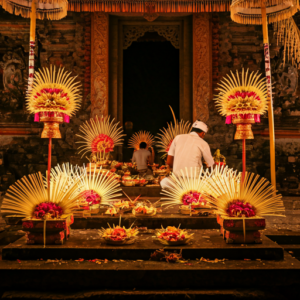
Balinese traditional music, epitomized by the mesmerizing sounds of the gamelan, forms an integral part of the island’s rich cultural tapestry. The gamelan is more than just an ensemble of instruments; it is a living tradition that reflects Bali’s spiritual life, community values, and artistic expressions. This essay explores the origins, instruments, musical styles, cultural significance, and contemporary relevance of Balinese gamelan music, shedding light on its enduring allure and profound impact on both local and global audiences.
Origins and Historical Context
The gamelan is an ancient musical tradition that dates back to at least the 8th century, although its exact origins are difficult to pinpoint. It is believed to have developed from indigenous musical practices influenced by Hindu-Buddhist cultures from India and Southeast Asia. Over centuries, gamelan music has evolved, incorporating various elements from different cultures while retaining its distinct Balinese identity.
- Cultural and Religious Influences: The spread of Hinduism and Buddhism to Bali played a crucial role in shaping the island’s musical traditions. Temples became centers of musical development, where priests and musicians used gamelan music as part of religious rituals and ceremonies. The incorporation of Indian musical scales and instruments added a new dimension to the evolving gamelan tradition.
- Royal Patronage: The courts of Balinese kings and nobility were instrumental in the flourishing of gamelan music. Royals not only supported the creation of new compositions but also established court gamelan ensembles, which became symbols of power and sophistication. This patronage helped standardize gamelan instruments and techniques, fostering a rich environment for musical creativity.
Instruments of the Gamelan
A gamelan ensemble comprises a variety of percussion, string, and wind instruments, each contributing to the ensemble’s unique and complex sound. The primary instruments include metallophones, gongs, drums, flutes, and string instruments.
- Metallophones: Metallophones, such as the gangsa and gender, are xylophone-like instruments with bronze or iron keys. These instruments produce a bright, resonant sound and are played with mallets. Different sizes and tunings of metallophones create layers of melodies and harmonies within the ensemble.
- Gongs: Gongs are essential to the gamelan ensemble, providing the foundational beats and punctuating the music with their deep, resonant tones. Key gongs include the gong ageng (large gong), kempur (medium-sized gong), and kemong (small gong). The gongs are typically struck at regular intervals, marking the structure and cycles of the music.
- Drums: Drums, or kendang, are central to the rhythm section of the gamelan. They guide the tempo and dynamics, coordinating the ensemble during performances. The drummer often acts as the leader, signaling changes in tempo and intensity.
- Flutes and String Instruments: The suling (bamboo flute) and rebab (two-stringed fiddle) add melodic and lyrical elements to gamelan music. These instruments often play more expressive and ornamented lines, contrasting with the percussive textures of the metallophones and gongs.
Musical Styles and Compositions
Balinese gamelan music encompasses various styles, each with its own distinct characteristics and functions. Some of the most prominent styles include Gamelan Gong Kebyar, Gamelan Angklung, and Gamelan Semar Pegulingan.
- Gamelan Gong Kebyar: Developed in the early 20th century, Gong Kebyar is known for its dynamic, explosive style. It features sudden shifts in tempo and dynamics, intricate rhythms, and virtuosic playing. This style is particularly popular in dance performances and competitions, showcasing the technical prowess and creativity of Balinese musicians.
- Gamelan Angklung: Traditionally used in rituals and ceremonies, Gamelan Angklung is characterized by its use of bamboo instruments and a simpler, more meditative musical structure. It is often associated with processions, temple festivals, and communal activities, reflecting the spiritual and communal aspects of Balinese life.
- Gamelan Semar Pegulingan: Known for its refined and lyrical qualities, Semar Pegulingan is a classical style that evolved from the court music tradition. It features a rich interplay of melodies and harmonies, often performed at royal events and important ceremonies. This style emphasizes subtlety and elegance, highlighting the intricate beauty of gamelan music.
Cultural Significance
Gamelan music is deeply embedded in Balinese culture, playing a crucial role in religious, social, and artistic life.
- Religious and Ritual Functions: Gamelan music is integral to Balinese Hindu rituals and ceremonies, providing a sonic backdrop for temple activities, offerings, and dances. It is believed to create a sacred atmosphere, inviting the presence of deities and spirits. Specific gamelan ensembles are designated for different types of ceremonies, from cremations to temple anniversaries.
- Community and Social Cohesion: Gamelan music fosters a sense of community and social cohesion. Ensemble members must work together harmoniously, listening to each other and synchronizing their playing. This collective effort reflects the Balinese value of **gotong royong** (mutual cooperation) and reinforces social bonds within the village or community.
- Artistic Expression: Beyond its ceremonial functions, gamelan music is a powerful form of artistic expression. Composers and musicians constantly innovate, creating new pieces and experimenting with different sounds and techniques. This dynamic creativity ensures that the gamelan tradition remains vibrant and relevant.
Contemporary Relevance and Global Influence
In the modern era, Balinese gamelan music continues to thrive and adapt, gaining international recognition and influencing global musical trends.
- Tourism and Cultural Exchange: Bali’s status as a major tourist destination has brought gamelan music to the attention of international audiences. Tourists can experience live gamelan performances at cultural centers, hotels, and festivals, fostering a global appreciation for this unique musical tradition. Cultural exchanges and collaborations with foreign musicians have also enriched the gamelan repertoire and techniques.
- Educational Programs: Gamelan music is taught in schools and cultural institutions, both in Bali and abroad. Workshops, classes, and university programs introduce students to the instruments, techniques, and cultural contexts of gamelan music. These educational efforts help preserve the tradition and inspire new generations of musicians.
- Contemporary Compositions and Collaborations: Modern composers and musicians have incorporated gamelan elements into various genres, from classical and contemporary music to jazz and electronic music. These collaborations have expanded the reach and influence of gamelan music, demonstrating its versatility and adaptability.
Challenges and Preservation Efforts
Despite its vibrancy, the tradition of gamelan music faces challenges, including modernization, globalization, and the influence of popular culture. Efforts to preserve and sustain this heritage are crucial.
- Cultural Preservation Initiatives: Organizations and cultural institutions in Bali are dedicated to preserving gamelan music through documentation, archiving, and research. These efforts ensure that traditional compositions, instruments, and techniques are recorded for future generations.
- Support for Local Musicians: Providing support and opportunities for local musicians is essential for the continuity of gamelan music. This includes funding for performances, instruments, and training programs, as well as promoting the importance of gamelan music within the community.
- Public Awareness and Engagement: Increasing public awareness and engagement with gamelan music is vital. Community events, festivals, and educational programs can help foster a deeper appreciation for this cultural heritage, encouraging more people to participate and support its preservation.
Conclusion
Balinese traditional music, exemplified by the enchanting sounds of the gamelan, is a profound expression of the island’s cultural, spiritual, and artistic identity. From its ancient origins and diverse instruments to its dynamic styles and cultural significance, gamelan music embodies the essence of Balinese life. As it continues to evolve and adapt in the modern world, the gamelan tradition remains a living testament to Bali’s rich heritage, captivating audiences and inspiring musicians worldwide. By preserving and promoting this unique musical form, we can ensure that the sound of gamelan continues to resonate for generations to come, celebrating the timeless beauty and communal spirit of Balinese music.





